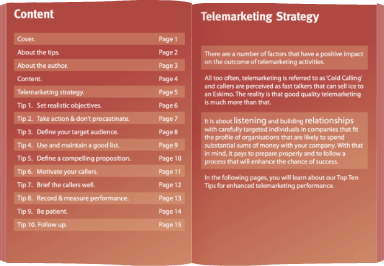Generating B2B leads is hardly a walk in the park. Yet, it’s an everyday, essential task that’s crucial for any business aiming to thrive in competitive markets. Companies, from start-ups to large enterprises, struggle to find good leads that become valuable clients.
This short guide will provide ten steps to help improve your business development process.
1. Crafting Your Ideal Customer Profile
An accurate customer profile is foundational in lead generation. It’s about more than just knowing the industries your prospects are in, or the size of their company. You also need to understand the roles of decision-makers.
An essential component is understanding the unique challenges your potential clients face. A well-crafted customer profile, with this in mind, enhances targeting precision, which can significantly boost engagement rates. A study on LinkedIn found that personalised messages using accurate customer information can boost click-through rates by 50%.
Tailoring your marketing efforts to meet the unique needs and interests of your audience can increase engagement. This, in turn, improves the likelihood of converting potential customers into loyal clients. And, that goes for whichever channel you use to reach your prospects.
2. Understanding Client Needs and Pain Points
Recognising and solving customer problems helps create a bond and demonstrates that your offerings are the ideal solution. Effective sales strategies involve aligning a product or service with customer needs. These needs may include saving money, improving performance, or increasing efficiency.
Matching the product or service with these specific needs is crucial for success in sales. For example, a Forrester report shows that businesses that fix customer problems can increase customer satisfaction scores by 30-50%. Match your solutions to what customers want. This will give potential customers good reasons to choose your services over others.
3. Building a Targeted Prospect Database
I always make the point that you can’t hit a target you cannot see. And, it doesn’t matter if you’re a crack shot if you’re aiming at the wrong target. A forensically compiled database is vital for efficient lead generation.
Quality here triumphs over quantity. You can’t choose who needs your services at the moment. However, having a targeted list can help save time and resources by focusing on interested parties.
Quantity is important for reaching more people, but quality is key for efficiency. Quantity is important for reaching more people, but quality is key for efficiency.
According to MarketingSherpa research, businesses that have optimised databases can increase their conversion rates by up to 70%. Updating your database regularly to match your target customer profile can make your outreach efforts more effective. This will lead to increased success in your campaigns.
There are plenty of ways you can achieve this, albeit it’s not necessarily a quick fix. This involves ensuring staff input data is accurate, checking data with online tools, and conducting manual research regularly.
4. Blending Push and Pull Marketing Strategies
Once you know your audience, this opens the door to efficient targeting. Important to recognise, though, that it’s a process that, in an ideal world, uses both push and pull strategies. Knowing what your audience likes and giving it to them when they want it can have a significant influence. Equally, reaching out to targeted influencers and decision-makers may unearth a need.
The synergy between push and pull marketing strategies can create a robust framework for building your sales pipeline. Push strategies involve reaching out to potential customers, through telemarketing or emails. Pull strategies attract leads through SEO or valuable content. Integrating these strategies can help maintain constant engagement with prospects, providing multiple touchpoints that enhance brand visibility and recall.
Balancing both strategies can help your brand stay memorable. It can also improve lead quality by 40%. This is according to businesses that have successfully used this approach.
5. Creating Interest Through Thought Leadership
Creating top-notch content can help establish your brand as a leader in your industry and attract potential clients. Creating valuable content like articles, white papers, and reports helps establish you as an expert in your industry.
Creating strategic content can triple relevant business opportunities, according to a study by the Content Marketing Institute. Your content should discuss trends and challenges in the industry. This will help you connect with and inform your target audience. Ultimately, this will guide them towards a sales discussion.
At GSA, we’ve been providing knowledge-based articles on our website, and on LinkedIn, for over 14 years. We have hundreds of advice-centric articles that can help companies in their quest for more leads.
Of course, it isn’t a quick fix. Without organic reach, not least with high search engine ranking, it can be hard to succeed. That’s where the blend of push and pull comes in, perhaps with sponsored ads, sponsored content, and SEO.
6. Identifying the Right Channels for Engagement
Choosing the right channels to disseminate your message is crucial for reaching your intended audience effectively. Different industries have favourite places for leaders to get information, like LinkedIn for professionals or specialized forums for specific sectors. Customising your channel strategy can improve your outreach effectiveness. HubSpot reported that businesses have seen a 33% increase in engagement by using channels tailored to their target audience.
The list of choices for business development is endless. These might include:
- Email Marketing: Direct email campaigns can be an option for personalised communication and nurturing leads through tailored content and offers.
- Content Marketing: Produce high-quality, relevant content like blogs, white papers, ebooks, and case studies to attract and engage potential clients.
- Search Engine Optimization (SEO): Optimise your website and content to rank higher in search engine results, making it easier for potential clients to find you when they are looking for solutions you offer.
- Pay-Per-Click Advertising (PPC): Using platforms like Google Ads or LinkedIn Ads to drive traffic to your website, where users can convert into leads.
- Social Media Marketing: Leveraging platforms like LinkedIn, Twitter, TikTok, and Facebook to share content, engage with prospects, and run targeted advertising campaigns.
- LinkedIn Sales Navigator: Utilising this specialised tool to target the right decision-makers, engage with personalised outreach, and track potential leads.
- Webinars and Online Workshops: Hosting online events to demonstrate expertise, engage with a broader audience, and gather leads through registrations.
- Trade Shows and Conferences: Attending or exhibiting at industry events to network with potential clients, showcase products or services, and collect contact information.
- Telemarketing: Using phone calls to reach out to potential clients directly, including following the other channel activity detailed here, offering a personal touch that can accelerate the sales process.
- Direct Mail: Sending physical items like postcards, brochures, or small gifts can help you stand out and reinforce your brand presence.
- Referral Marketing: Encouraging satisfied customers and partners to refer new clients to your business.
- Account-Based Marketing (ABM): Focusing marketing efforts on a clearly defined set of target accounts within a market and employing personalised campaigns designed to resonate with each account.
- Networking: Building relationships through professional groups, associations, and business networks can provide warm leads and introductions.
- Retargeting Ads: Using online ads to target users who have visited your website but did not make an immediate purchase or inquiry.
- Influencer Marketing: Partnering with influential figures in your industry to tap into their networks and gain credibility among your target audience.
- Podcasts: Either hosting your own or appearing on relevant industry podcasts to share expertise and capture the attention of engaged listeners.
7. Being There When It Matters
Easier said than done, but the timing of your engagement can critically impact lead conversion. Being present during key decision-making periods—through targeted ads, search engine optimisation, or timely follow-ups—can significantly influence purchasing decisions. Research shows that companies who interact with potential clients at the right time can increase conversion rates by more than 50%. Understanding the buyer’s journey and ensuring visibility during critical phases are paramount for converting interest into sales.
Whilst the theory is right, the reality may be challenging. First, you don’t know who is in the market when, and second, demand is hardly consistent. Companies have distinct year-ends. They buy at different times.
Organisations are at varying stages of development, meaning they will have diverse requirements at different times. So, it often involves effort across a wide range of disciplines for the visibility to be timely.
8. Patience Pays Off
Filling the sales funnel takes time and patience, especially in industries with long sales cycles and high purchase costs. It requires a strategic approach and commitment to see results.
Nurturing leads until they are ready to engage meaningfully with your business is essential. Research indicates that nurtured leads make 47% larger purchases than non-nurtured leads. By being patient, you can be there when the opportunity arises to make the most of your efforts.
In many cases, this is a tough thing to accept, especially for senior management. Stakeholders want fast results. ROI is a constant requirement. In truth, B2B marketing does not regularly see patience as a virtue.
Always pressure to generate new business and to deepen engagement, and spending, with existing clients. But it’s essential to be realistic.
9. Aiming for Long-Term ROI
Adopting a long-term perspective in your sales efforts is crucial for achieving sustainable growth. The benefits of building relationships and investing in continuous engagement strategies are substantial, often leading to a higher lifetime value per customer. Studies show that long-term strategic marketing efforts can enhance return on investment by up to 50% over time, as continuous engagement keeps your brand in front of potential leads, encouraging ongoing transactions and fostering customer loyalty.
Consider internal experience and external recommendations when making decisions. While some agencies may try to buy your business with lavish promises about how many opportunities they can generate over a short period, be pragmatic when it comes to the speed of the return on investment for quality leads.
10. Consistency and Persistence
Consistency and persistence are vital components of a successful lead generation strategy. Regularly refining your approach and maintaining your efforts, even when immediate results are not evident, can build a pipeline that delivers steady returns. A consistent approach ensures that your marketing efforts are continuous and adaptive to market changes, which can ultimately yield a 35% increase in the success rate of your campaigns.
A lack of follow-up can seriously hamper your business development efforts. Yet, it’s an issue that prevails in many organisations. Red-hot opportunities are notoriously sought after by sales teams. Of course, we all do. But not every prospect is ready to go. Some are in the evaluation phase. Others are at the start of their journey. While time is valuable, dropping a prospect too soon could prove terminal. Qualification and profiling are crucial. But, with long sales cycles, and high sales values comes a requirement for consistency, in terms of communication, and persistence in terms of regularity of contact. That’s the recipe for better outcomes.
Why Outsourcing Might Be Your Best Strategy
Mastering these ten steps can significantly enhance your lead flow, transforming sporadic results into a consistent and successful lead acquisition process. However, achieving this level of precision and efficiency internally can be challenging. Outsourcing to an experienced partner like GSA not only alleviates the burden of managing complex top-of-the-funnel activities but also ensures that your efforts are optimised for possible outcomes. Your business can focus more on core activities, ensuring a better allocation of resources and superior results, by letting experts handle business development activities where you have internal gaps.






